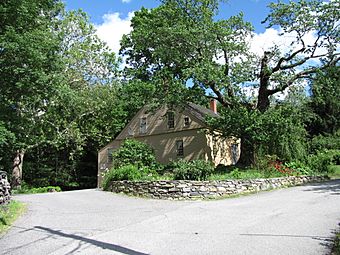Freegrace Marble Farm Historic District facts for kids
Quick facts for kids |
|
|
Freegrace Marble Farm Historic District
|
|

Freegrace Marble Farm
|
|
| Location | 80 Burbank Road, Sutton, Massachusetts |
|---|---|
| Area | 63 acres (25 ha) |
| NRHP reference No. | 89001967 |
| Added to NRHP | November 13, 1989 |
The Freegrace Marble Farm Historic District is a very old farm in Sutton, Massachusetts. Even though many buildings are from the 1800s, the farm still looks like it did in the 1700s. It includes land given to Freegrace Marble in 1717. He was one of the first settlers in Sutton. This special place was added to the National Register of Historic Places in 1989.
Contents
Exploring the Historic Freegrace Marble Farm
The Freegrace Marble Farm is in a quiet, country part of northern Sutton. You can find its buildings where Burbank and Sibley Roads meet. The farm covers about 63 acres (25 ha) of land. This land is split between open fields for farming and thick woods.
Farm Features and Old Stone Walls
Many parts of the farm are lined with old stone walls. Some of these walls are very well-built, especially near the main farm buildings. These walls show how people used to mark their land. They also show how much work went into building them long ago.
The Marble Family Cemetery
Near the northern edge of the farm, there is a small family cemetery. The oldest tombstone you can read is from 1786. However, we know that Freegrace Marble, who started the farm, is buried there too. He passed away in 1775. This cemetery helps us remember the family who lived here for many years.
Main Farm Buildings
The main house on the farm is a 1-1/2 story Cape style house. It is made with strong wooden planks. This house sits on the south side of the road junction. Right across the street, on the north side, you will find other farm buildings. These include two barns and a toolshed. This setup, with the house on one side and the barns on the other, was common in the 1700s.
History of the Freegrace Marble Farm
The area that is now Sutton was settled by English colonists. These settlers arrived in the 1710s. The land had been bought from the Nipmuc Native American tribe in 1704. Freegrace Marble was one of the first thirty settlers. He came to the new community in 1717.
Freegrace Marble's Original Land
Freegrace Marble started his farm on more than 250 acres (100 ha) of land. The main part of his farm, including his first farmhouse, went to his son Malachi. This happened when Freegrace died in 1775. The original farmhouse is no longer standing today. It is thought to have been west of the current house.
Malachi Marble and the Present House
Malachi Marble built the house that stands on the farm today. He raised twelve children in this house. The main part of the farm stayed in the Marble family for a long time. It was owned by Marble descendants until 1895. The way the farm is set up, with the house separate from the barns, shows how farms looked in the 1700s. Later, in the 1800s, farms often had the house connected to the barn.



